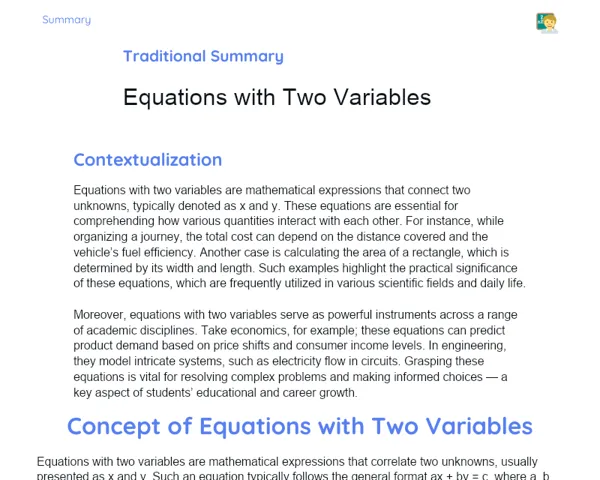Goals
1. Understand the concepts of angle bisector and perpendicular bisector as important geometric elements.
2. Identify the perpendicular bisector and angle bisector in various geometric figures.
3. Explore practical applications of these concepts in real-life scenarios and job opportunities.
Contextualization
Angle bisectors and perpendicular bisectors are essential concepts in geometry, applicable in many everyday situations. For instance, when planning a road that bisects two towns or designing a symmetrical pattern in art, these concepts play a pivotal role. Grasping these geometric principles aids in solving real-world issues and helps in visualising and constructing well-balanced shapes.
Subject Relevance
To Remember!
Angle Bisector
An angle bisector is a line segment that divides an angle into two equal halves. This concept is key in geometry, representing a locus of points that are equidistant from the sides of the angle.
-
The angle bisector splits an angle into two congruent angles.
-
All points on the angle bisector are equally distant from the sides of the angle.
-
The angle bisector can assist in solving geometric construction problems.
Perpendicular Bisector
The perpendicular bisector of a line segment is the line that intersects the midpoint of the segment perpendicularly. It represents a locus of points that are equidistant from the endpoints of the segment.
-
The perpendicular bisector intersects the segment at its midpoint at a right angle.
-
All points on the perpendicular bisector are the same distance from the segment's endpoints.
-
This concept is used in various practical applications, such as finding equidistant locations in urban development.
Geometric Places
Geometric places are collections of points that share a specific geometric property. Both the angle bisector and perpendicular bisector exemplify geometric places as they indicate sets of points with defined distance relationships.
-
Geometric places help in problem-solving and constructing geometric figures.
-
The angle bisector consists of points equidistant from the angle's sides.
-
The perpendicular bisector includes points that are equidistant from the segment's endpoints.
Practical Applications
-
Civil Engineering: Applying angle bisectors in the design of structures like bridges and tunnels that require exact divisions.
-
Urban Planning: Using the perpendicular bisector to determine equidistant locations for infrastructure like cellphone towers.
-
Graphic Design: Incorporating angle and perpendicular bisectors in the creation of logos and balanced layouts.
Key Terms
-
Angle Bisector: A line segment that divides an angle into two equal parts.
-
Perpendicular Bisector: A line that passes through the midpoint of a line segment and is perpendicular to it.
-
Geometric Places: Collections of points that share specific geometric properties.
Questions for Reflections
-
How can understanding the angle bisector and perpendicular bisector assist in addressing real-world issues in engineering and architecture?
-
How can knowledge of geometric places benefit graphic design projects?
-
Why is it crucial to grasp the concepts of angle bisector and perpendicular bisector for effective urban planning?
Designing the Ideal City
Apply the principles of angle bisector and perpendicular bisector to plan and design an ideal city, ensuring symmetrical arrangements and equidistant landmarks.
Instructions
-
Form groups of 4 to 5 students.
-
Utilize graph paper, rulers, compasses, and pencils to create your city design.
-
Draw main roads using perpendicular bisectors, ensuring main buildings are equidistant.
-
Employ angle bisectors to symmetrically divide blocks, organizing residential, commercial, and recreational areas.
-
Present your city design and explain how you applied the concepts of angle bisector and perpendicular bisector in your planning.

